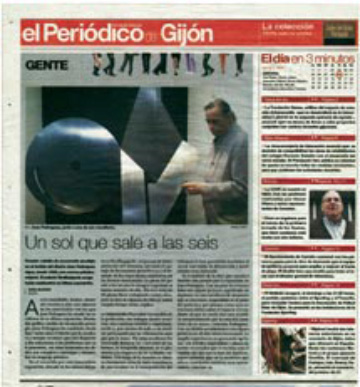

A Sun that Leaves to Six
EL PERIÓDICO DE GIJÓN
09-08-2002
Xana Iglesias
A Catalan creative figure of recognised prestige in the field of design, since 1998 Joan Pedragosa has also been pursuing an original career in the plastic arts. Until September the Revillagigedo Palace will be hosting his latest exhibition.
Stainless steel, bronze, naval aluminium and zinc are some of the materials Joan Pedragosa has used to create the sculptures for his latest exhibition. A Catalan graphic designer of recognised prestige, several years ago Joan Pedragosa exchanged design for sculpture and though he recognises that he is ready to offer solutions to the problems he might be presented with, “at this moment in time I devote myself wholly to investigating and developing a plastic language.”
On a tour of this innovative exhibition in the rooms of the Revillagigedo Palace, the interpretation of volume is striking, as is the handling of geometric devices and the command of the expressive potential of the most elementary forms. The piece Sol que sale a las seis (“Sun that comes up at six”) is a good example of this. “I’ve been working on this series of 28 pieces for four years, but the idea for some of them had appeared some time before,” he explains.
Perfection / Tireless in his quest for perfection, his final works reveal a constant revision and experimentation and, above all, show us a sculptor concerned more with volumes than with masses. “In these sculptures I have tried to bring out the contrasts between the forms, the absolute search for the geometry and elegance of careful finishes” Throughout the exhibition it can be observed how this sculptor’s vast experience in the interpretation of volume has made it possible for him to translate into metal a highly elaborated vision of abstraction and movement.
It is the name of the work that crowns or completes this stroll through Joan Pedragosa’s exhibition. With a weight of eighty kilos, this primate bird, which is what Depitecus means, is a sculpture of naval aluminium that is hung in the patio of the palace and that floats like an ethereal structure over the space around it “which it does not annul but rather temporarily modifies by the insistent rotation of its mass,” Pedragosa comments. With an aerodynamic design this figure silently penetrates the air. Wide experience in optional geometry, with hanging mobiles and cut-out cardboard planes that moved with changes in the air, is behind the Depitecus, the primate bird that “is the sculpture that offers the most interesting aesthetic qualities,” he concludes.